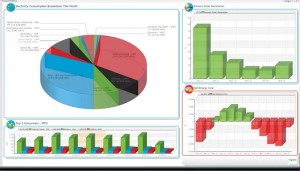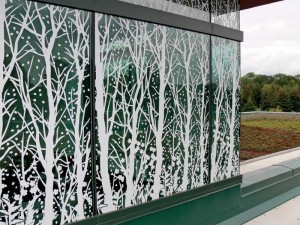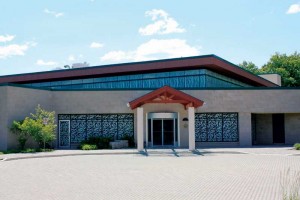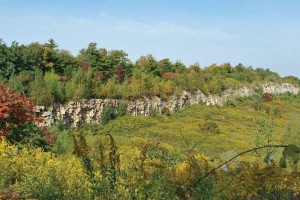Building heavy with the Earth Rangers

Biodiversity considerations
No building analysis would be complete without Earth Rangers examining the impact of its operations on biodiversity. Marrying biodiversity issues and the ongoing operations is not new to the organization. Bird-strike prevention film was installed in 2006 and additions made again in 2011. The window treatment prevents migrating birds from hitting the glazing of the daylit office space windows; the material’s inclusion subsequently earned an innovation credit under the LEED NC certification process.
Recent programs have led the team to investigate the relative impact on biodiversity of forestry, mining, and general material selection for building. Factors impacting material selection include whether sustainable forestry practices are used, if aggregates are recycled, and how materials are processed.
Comprehensive examination of how construction affects animals and their habitats should encompass the broad spectrum of factors affecting biodiversity throughout the material’s lifecycle. Three metrics help break down the components of this impact:
- initial embodied energy—raw materials extraction, manufacturing, transportation, and initial biodiversity loss;
- recurring embodied energy—maintenance and repair; and
- operational energy—building operations. (See I.Z. Bribián et al’s 2011 article, “Lifecycle Assessment of Building Materials: Comparative Analysis of Energy and Environmental Impacts and Evaluation of the Eco-efficiency Improvement Potential,” in Building and Environment [46:1133-1140]).
The recurring embodied energy and operational energy phases can have additional lasting negative effects on wildlife, in addition to the initial impacts associated with acquisition of raw building materials and the construction process. Lifecycle assessment (LCA) is the comprehensive, three-phase approach to achieving an optimally sustainable industry (specifically construction, in this case). (See J. Carmody and W. Trusty’s 2005 piece, “Lifecycle Assessment Tools,” in InformeDesign. Visit www.informedesign.org).

A critically valuable method for evaluating possible environmental threats throughout a product’s life and its total energy footprint, LCA has been the focus of dozens of building materials studies and reviews. (See I. Sartori and A.G. Hestnes’s 2007 article, “Energy Use in the Lifecycle of Conventional and Low-energy Buildings: A Review Article,” in Energy and Buildings [39:249-257]). Potential environmental threats include depletion of fossil fuels and other natural resources, water use, pollution, emission of greenhouse gases (GHGs) and associated atmospheric effects, and ecological toxicity.
Loss of biodiversity is another critically important aspect that should be included in LCA studies, but is often overlooked. Lack of consideration of biodiversity impact may be partly explained by the fact the nature of biodiversity loss—habitat type affected, most appropriate scientific tools to assess the impact, extent of the impact in terms of space and time, and long-term ecological consequences—is complex and differs with the type of construction and industry. There are no metrics on which there is general agreement.
Initial embodied energy is usually quantified as non-renewable energy consumed per unit of building material, component, or system. It is expressed as a unit of energy per unit mass or volume. In a recent report, 30-MPa grade concrete and wood ranked sixth and eighth lowest, respectively, for initial embodied energy out of 29 different building materials. While concrete (1.3 MJ/kg) and wood (2.5 MJ/kg) had relatively similar values, steel was 20th out of 29 (32 MJ/kg). (See Ted Kesik’s article, “Perspectives on Sustainability,” published in the January 2002 issue of Canadian Architect). This data alone implies concrete and wood may also have lower (and similar) initial environmental impacts on certain components of biodiversity, relative to a steel building of comparable size. (See S. Xing et al’s 2008 article, “Inventory Analysis of LCA on Steel- and Concrete-construction Office Buildings,” in Energy and Buildings [40:1188-1193]).

Other studies based on direct manufacturing comparisons of same-sized structural concrete, wood, or steel industrial buildings have also found concrete and wood to have similarly low initial embodied energy values. (See R.J. Cole and P.C. Kernan’s 1996 article, “Lifecycle Energy Use in Office Buildings,” in Building and Environment [31[4]:307-317]). These values are also markedly lower than buildings based on steel construction. Initial energy concepts of the Earth Rangers Centre directly compared light, traditional steel construction to heavy, thermal mass construction, predicting operational savings of approximately 50 per cent when integrated with the other concepts mentioned.
Nonetheless, the actual biodiversity impacts of construction are unclear and require scientific investigation. Further, data that permits direct and transparent quantitative comparisons of how building materials impact biodiversity are logical and necessary, but require industries to agree on using consistent scientific methodologies. A Canadian equivalent to the U.S. Life Cycle Inventory Database, managed by the National Renewable Energy Laboratory (NREL), would be highly useful in this regard. (Visit www.nrel.gov/lci/about.html).
Thoughtfully chosen integrated building technologies, such as the specialized air-handling and geothermal systems found in the ERC, reduce recurring embodied energy and operational energy impacts on biodiversity. These building attributes can ameliorate the overall ecological footprint of a particular building. Recycling end-of-life concrete building products can further contribute to eco-responsible construction practices. Using renewable materials as an alternative to traditional clinker for cement manufacturing is predicted to reduce cement industry CO2 emissions by as much as 50 per cent.

A new experimental approach to recycling accumulated limestone dust in quarries also offers additional environmental responsibility options for the construction industry. (See M. Galetakis et al’s 2012 article, “Evaluation of Fine Limestone Quarry By-products for the Production of Building Elements: An Experimental Approach,” in Construction and Building Materials [26:122-130]). The approach includes ultra-compaction and transformation into usable building materials. Innovative approaches like these provide a glimpse into a future with less ecological impact from building materials.
Conclusion
Since Earth Rangers’ move into the building in 2004, energy consumption has been decreased by an average of 10 per cent annually, while building occupancy has gone up. In 2011, energy consumption was 42 per cent better than what even Transsolar’s model predicted. Some of this is due to functional changes in how the building is used, as well as system changes.
Additional construction costs related to the thermal mass were estimated at $120,000 in 2003. In combination with the other integrated strategies described in this article, and taking into account increased energy costs, these systems have already paid for themselves. Individually, some of the strategies implemented admittedly have longer investment horizons. Integrated together, it is hard to argue with the recently achieved Energy Star rating of 95.

The choice of concrete also brings operational challenges. Concrete construction can make major renovations of spaces more difficult. Careful care must be taken to not puncture embedded radiant tubing whenever something needs to be embedded in a ceiling (e.g. light fixtures). Controlling sound in the open-concept office spaces with radiant concrete ceilings is a challenge that Earth Rangers found after taking occupancy. These issues are addressable, and the incentive to do so is given throughout this article.
Globally, 24 per cent of all raw materials extracted from the earth are used for building construction, while subsequent processing, manufacturing, and transportation require staggering amounts of energy. Emphases on making more sustainable building choices and the use of cutting-edge technologies have never been stronger, thus revolutionizing the construction industry. Canada’s building community continues to pursue more sustainable building designs and practices, including more energy-efficient materials, green technologies, and support of various building certifications, like the LEED rating obtained by the Earth Rangers Centre for Sustainable Technology.
Mark Northwood, president and co-CEO, sees the decision to focus so much of the ERC’s design around concrete as an important one.

Photo courtesy Holcim Canada Inc.
“We chose concrete as the material of choice for our building because of its comparatively low impact on biodiversity, its longevity, and thermal qualities,” he says. “We also believe in aggregates as a top choice for building materials because of the cement industry’s ability to recover, and, in most cases, increase the state of biodiversity on their properties.”
The concrete industry, like many others, is working on innovative ways to reduce the energy required to harvest, transport, and prepare the product for use. Concrete has inherent durability advantages that are difficult to argue, and the industry has only begun to take advantage of the material’s potential thermal mass properties.
Preference for particular building materials is a choice for each architect, owner, and operator. However, sustainable choices should be made whenever possible to push all building industries toward continued innovation which reduces the environmental burden of their much-used construction products.
Andy Schonberger, P.Eng., MBA, LEED AP, is the director of the Earth Rangers Centre for Sustainable Technology. He guides facility operations decisions, while sharing lessons learned with the building community. Schonberger is a director with the Toronto Chapter of the Canada Green Building Council (CaGBC), where he chairs the Marketing and Communications Committee. He can be contacted at aschonberger@earthrangers.com.
Scott Tarof, PhD, has more than a decade of research and project management experience in ecology and conservation, and has taught 22 university courses in Canada and the United States. At Earth Rangers, he is responsible for the science behind the organizations’ conservation programs. Tarof manages a panel of external scientists from across the continent that support Earth Rangers in its conservation efforts. He can be reached via e-mail at starof@earthrangers.com.







